|
96. Aglais urticae (Linnaeus, 1758) / Small tortoiseshell / Nymphalidae – Nymphalinae
NL: kleine vos / D: Kleiner Fuchs / F: petite tortue, le petit renard
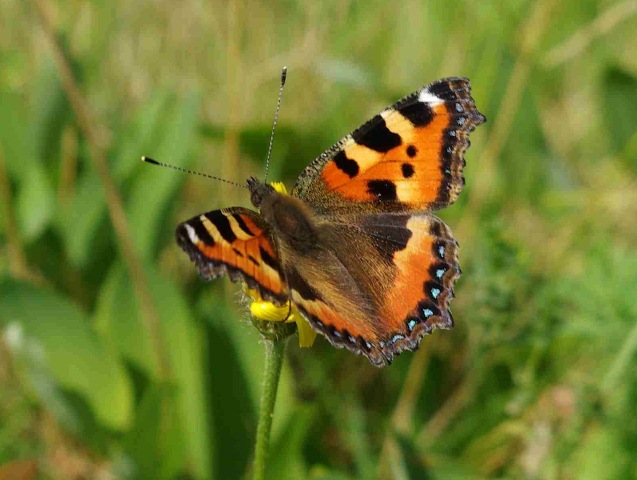   Photographs: Frits Bink, Frits Bink, Rosita Moenen ©. Photographs: Frits Bink, Frits Bink, Rosita Moenen ©.
Medium-sized, wing length 23 (22-25) mm. This species occurs everywhere in The Benelux in the countryside, urban area and dunes. People know this butterfly as the announcer of spring in the garden, but to find the larvae one has to look for them in open fields. The summer generation may be abundant in the flower garden.
Butterfly is on the wing from late-March until early-May and the offspring from early-June until late-September. There is a difference in phenology, in Wallonia the peak of the summer brood is mid-July whereas in Flanders and the Netherlands is end-August. The species is known from maritime and severe continental climates, amplitude 4 to 20. Required heat sum is 200°d and the maximum tolerated 2000°d, corresponding climate windows 15 and 38 weeks.
A lot of research has been carried out concerning its dispersal behaviour and life cycle (Roer, 1978), development and temperature (Niehaus, 1982) and temperature tolerances (Bryant et al., 1997). The maximum recorded distance migrated by a butterfly of this species was 150 km, the required temperature for growth 10.6°C, the maximum tolerated 33.6°C.
The species occurs from the Nord Cap, Norway south to the mountainous area of southern Spain and it adapts to obtain as much warmth as possible in cold environments and to escape excessive heat in Mediterranean regions.
Ecological characteristics
Behaviour over time
Overwintering: adult in hollow trunk, cave, stable, garden shed and unheated house.
Reproduction: in spring or summer 5-11 days when the body contains about 300 eggs. The adult can produce several clutches of eggs over a period of about eight weeks, the biggest ones in the beginning, smaller ones at the end.
Larval feeding periods: 2-3 weeks in period end-April until early-September.
Generations: variable, one to three.
Spreading of risk: flexible diapause in the adult stage, one clutch produces a percentage of individuals that will enter diapause despite warm weather and long daylight.
Life cycle: egg 8 (6-13) days; larva 18 (13-29) days; pupa 10 (8-18) days.
Life span of adult: summer generation 6-8 weeks, overwintering generation 35-45 weeks.
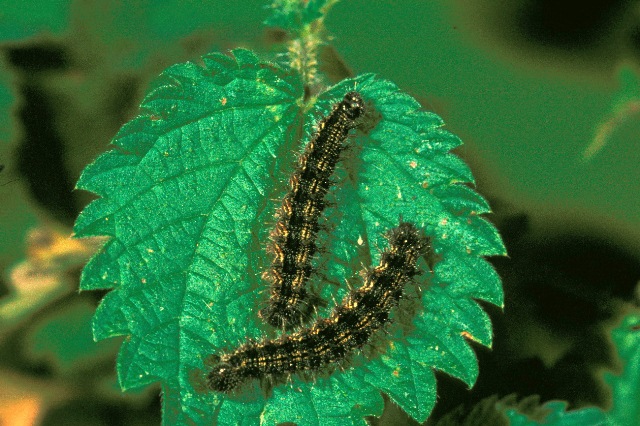 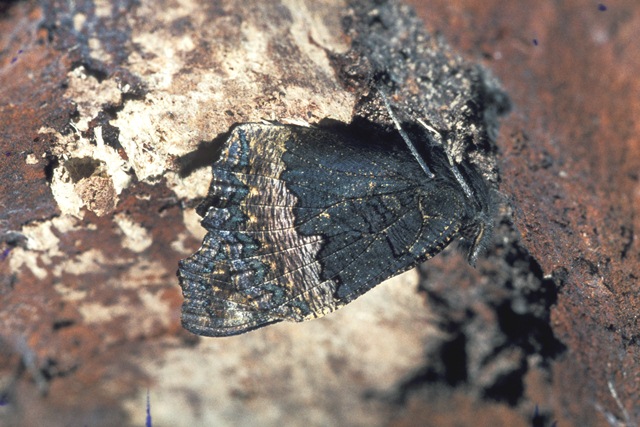
Photographs: Frits Bink ©.
Behaviour in space
From stay-at-home to migrant: nomad, spatial requirement great.
Finding a mate: male perches and patrols from time to time.
Orientation in the landscape: edges and verges in an open landscape.
Oviposition: big clutches of 150-300 eggs on the underside of a leaf at the top of a nettle stem.
Defence
Threats from other organisms: larva is armoured by spines and has warning colours black and yellow and when heavily disturbed it vomits.
Threats from the environment: larva and adult are vulnerable to heat and drought.
Feeding habits
Adult: nectar, all kind of flowers.
Larva: lives gregariously in a silk web, in last instar individually; during hot and dry weather the larva protects itself by hiding in a curled leaf.
Larval foodplants
Plant species: Urticaceae, Urtica dioica.
Journal
Rearing experiment based on specimen from Bennekomse Meent, Netherlands:
7 July 1983: old female captured that was ready to oviposit.
10 July: 135 eggs laid in 45 minutes in the morning. Before ovipositing the female drums with its front legs for five minutes to test the chemical quality of the leaves.
13 July: eggs near hatching.
19 July: larvae in third instar.
Last week in July: pupated.
First week in August: hatched.
Table 96-1. Results of dissections

Table 96-2. Collection and observation localities
D, Kaiserstuhl, Badberg, 433 m, 48° 05’ 47”N – 7° 40’ 40”E; 9 July 1985.
D, Kaub, 50° 05’ 36”N – 7° 45’ 43”E; 26 May 1986.
D, Lorch, 300m, 50° 02’ 05”N – 7° 47’ 56”E; 31 July 1985.
EST, Endla Nature Reserve, 58° 52 34”N – 26° 16’21”E; 10 July 1999.
EST, Viruna, 58° 28’ 51”N – 23° 58’ 32”E; 5 July 1999.
F, Montmédy, 217 m, 49° 31’ 07”N – 5° 21’ 33” E; 12 June 1984, 18 August 1984.
F, Lorraine, Dieue-sur Meuse, 49° 05’ 11”N – 5° 27’ 25”E; 19 August 1984.
F, Lorraine, Rupt devant Saint-Mihiel, 280 m, 48° 53’ 01”N – 5° 24’ 10”E; 28 June 2006.
F, Vosges, Grand Ballon, 1424 m, 47° 54’ 04”N – 7° 05’ 54”E; 26 July 1983.
F, Vosges, le Zinnkoepfle, 481 m, 47° 57’ 56”N – 7° 15’ 08”E; 10 July 1984.
NL, Amerongen, garden 52° 00’ 01”N – 5° 27’ 34”E; 1975-1986.
NL, Bennekom, garden 51° 59’ 30”N – 5° 40’ 34”E; 1988-2014.
NL, Leersum, garden 52° 00’ 29”N – 5° 24’ 04”E; 1975-1986.
NL, Bennekomse Meent, 52° 00’ 22”N – 5° 35’ 34”E; 7 July 1983 (ovipostion).
S, Östhammar, 60° 23’ 01”N – 18° 26’ 51”E; 19 August 1985.
S, Gotland Hummelbosholm, 57° 11’ 48”N – 18° 32’ 56”E; 8 July 2004.
S, Gotland, Klinteklinten, 57° 40’ 14”N – 18° 46’ 26”E; 13 July 2004.
S, Gotland, Östergarn, 57° 24’ 43”N – 18° 43’ 27“E; 15 July 2004.
S, Öland, Frösslunda, 56° 32’ 34”N – 16° 35’ 12”E; 22 July 2004.
Fig. 96-1. Aglais urticae, phenogram adapted from Bos et al. 2006: 264 (darker partl) & Fichefet et al. 2008: 161 (ligher part).
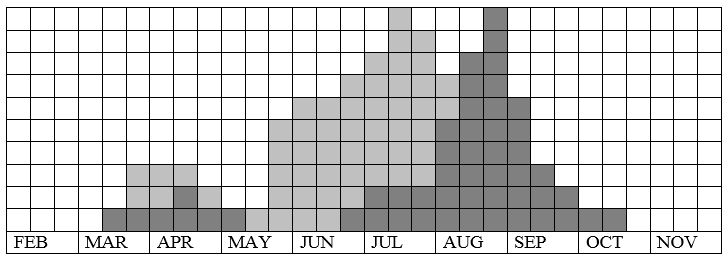
Fig. 96-2. Aglais urticae, habitat characteristics.
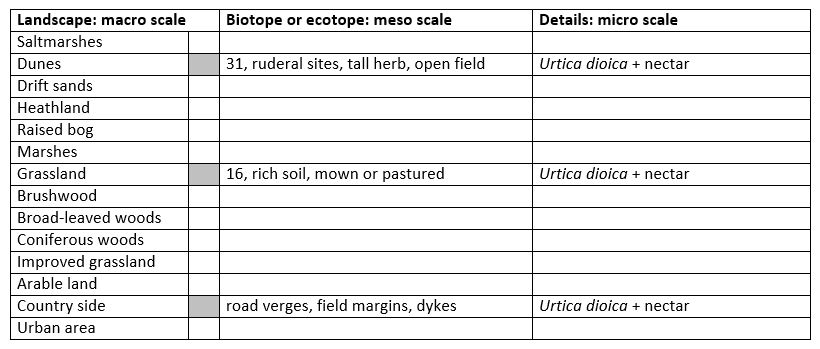
Fig. 96-3. Aglais urticae, climate matrix, heat-sums 200 - 2000°d.
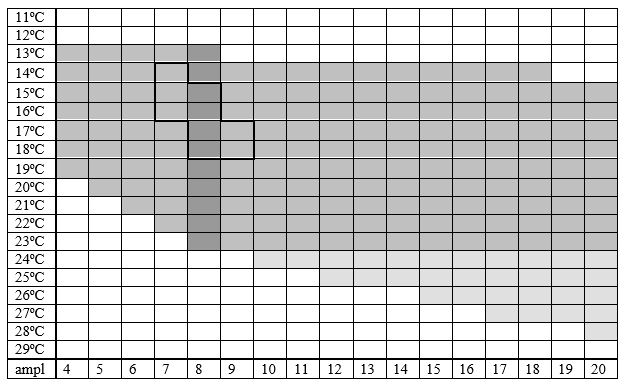
|










